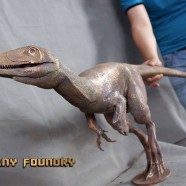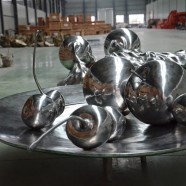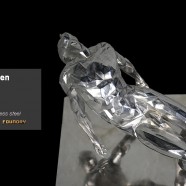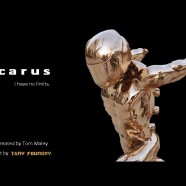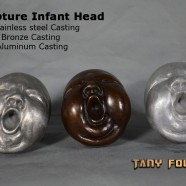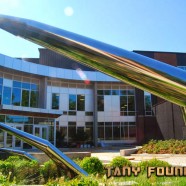4 Ways 3D Tech Can Help Sculptors
As the pioneering art foundry in China exploring help to apply 3D tech to help sculptors create works. we’d like to share a few of our thoughts. (1) Pre-Visualization Compared with traditional clay modeling, 3D modeling can quickly visualize your ideas. It is very useful in you design phase when you want to modify your model or make a series variation of a piece of sculpture. (2) Integrate 3D Tech with Art Foundry process The traditional process of clay modeling – bronze casting is been taken place by 3D scanning/ printing- bronze casting process. It is not only faster but also more economical. (3) 3D Scan your original work for virtual exhibition. By 3D scanning your own work, you can exhibit it anywhere around world without physically sending off the piece to a place. 3D virtual exhibition can greatly boost the influence your works and make the collectors know your sculptures much better than 2D images. (4) 3D Scanning Help Restore Old Sculpture By 3D scanning your own sculptures, you can reserve its 3D image permanently, which can be use to maintain the sculpture after a few years. This tech is extremely helpful to save the old sculptures. Below are a few works we produce by integrating 3D tech with metal casting. I’d like to hear your opinions on how 3D tech has change the way you create artworks. Please contact us. ...
Read MoreEaster Bunny Sculpturatural Project
A man’s limit is his own limitation. With the help of artist’s talent, amazing artworks can be created. Tany Foundry is so honored to collaborate with artist Brigita and Sandis to produce a wonderful Easter Bunny aluminum cast sculpture, which consists of a big bunny, lots of vegetables and fruits. The bunny sculpture is 7.5 feet tall. We combine lost wax casting with lost wax casting to maximize the best possible artistic appearance. Then we highly polished the sculpture pieces. Below is are photo documentation showing how we make it. Here is the rendering drawing of the sculpture. We make the patterns of the sculptures. We cast aluminum and are chasing them. It is very difficult to cast some of the fruits becuase there are thin. We combine lost wax casting and sand casting to succsffuly make them. After very careful chasing and cleaning the aluminum casting, we move on polishing. We employ three step polishing system to polish all the pieces. The result is stunning. Here are a few photos showing the finished works. We use 24K gold leaf for gilding the Easter bunny. The textures of the rabbit is wrinkle like and we keep all the textures carefully. The gold gilt sculpture looks really beautiful. Feel free to let me know if you have any technical question for this or your own project. Please click the button below if you need an estimate for your own...
Read MorePolished Stainless steel Sculpture We Cast
Stainless steel cast sculpture looks really beautiful and intriguing if done well. However, duo to its extremely high melting temperature (1800 degree Celsius) and tough chasing & finishing process, it is much more difficult to cast stainless steel than cast bronze. There are types of stainless steel for casting sculptures options: stainless steel Grade 201, stainless steel Grade 316, stainless steel Grade 316L. We can cast all of them. However, we recommend stainless steel 316 for sculpture as it is marine grade alloy, featuring superior corrosion resistance performance even in salty water. Below is a stainless steel sculpture we recently cast. We cast with stainless steel Grade 316 and polish it a little bit to make it shiny. Here is our work flow. Step One: Making the pattern. We use modern 3D printing technology to make the pattern from a digital model our client provides us. Step Two: Making silicon rubber mold Step Three: Make Wax Step Four: Cast stainless steel and polish Feel free to contact us if you need an inquiry of your own project....
Read MoreHow to Integrate 3D Printing with Bronze casting for sculpture
3D Printing is on its way to revolutionize how sculptors works. Tany Foundry is the first fine art foundry in China exploring how to employ 3D printing technique into bronze casting. In this short tutorial, I am going to show you how and why 3D Printing is helpful to create sculptures, even for “traditional sculptors”. Also, I will use a project we recently accomplished to show you the process step by step. Step 1: Creating 3D model Overall, there are two ways to create 3D model. 3D Scanning Digital Modelling 3D Scanning Digital Modelling Use 3D laser scanner to scan the physical object to generate a digital model of the sculpture. If you’ve already sculpted a sculpture maquette, you can have it 3D scanned it. The scanned model has to be refined and remodeled before 3D Printing. Below is a photo of the 3D Scanner we use for scanning.It is a four lens scanner with scanning accuracy 0.015MM. Use computer software to create the digital model virtually. The commonly used software are 3D Max, Maya, Zbrush, Rhino. The biggest benefit of using 3D printing to create sculpture is what it allows you the maximum flexity and freedom to make your works without needing to worry about cost and time. It is much easier to modify a sculpture than on clay. Besides, it costs less, both in time and money. Four lens 3D scanner we use for scanning objects, which features high scanning accuracy and speed. Above are the most often used 3D modelling software. In another tutorial, I am going to demonstrate how to choose the right software. This is the digital model of the sculpture, which is for us to 3D print and cast bronze. The artist creates the digital model by 3D scanning his maquette. Step 2: 3D Printing There are a few options of 3D Printings. Below are some of the most commonly used, which are chosen based on the size and printing of your sculpture. 3DP : Used for small sized object. It can be useful when you need your sculptures to be printed in color. MEM: It features high strength and low cost. The accuracy is not very high. SLS: It can print out different material, even metal. SLA: It is useful for small sized works. Accuracy is acceptable. After data processing, we 3D print out the digital model. We choose the High Definition mode to make the surface of the sculpture smooth. Please note, even printing with the most advanced printer, the surface of the sculpture has to be sanded and smoothened. For some low end 3D printer, there will be lots of layered line left on the surface so you need to make sure to sand it completely. We suggest using very fine sand paper for sanding the 3D print. The sand paper we use #1000 and #2000. Step 3: Molding We make rubber mold as well as wax mould from the 3D print. It is important to compare the wax with the 3D as well as the original digital model very carefully and retouch the wax if necessary. There are two options for bronze casting: lost wax casting and sand casting. Since most of 3D print is small in size, we use lost wax casting technique in most cases. Step 4: Bronze casting Just like on wax, the finished bronze casting has to be compared with the 3D print thoroughly and refined if necessary. If you have any technique question about how to apply 3D printing to sculpting or need a quote for your own work,Please...
Read MoreTips of Choosing Metal Alloy For Sculptures
Knowing the options and difference between metal alloys is the foundation to create beautiful sculptures. The most three commonly used metal alloy in fine art foundry is bronze, aluminum and stainless steel, which features different mechanical property and application. In this post, we’d like to introduce the major difference, as well as the upsides and downsides of each option so you can make achieve the ideal artistic appearance for your sculpture project at minimal cost possible. Here are photos of sculptures named “infant heads” which are cast with these three alloys. The left is stainless steel casting. It looks silver like after proper surface treatment and finishing. The middle is bronze casting. It looks more “traditional” . The right is aluminum casting. Aluminum casting is more and more employed nowadays to replace bronze for a couple of reasons. Below is the takeaway for this post. Bronze Casting Aluminum Casting Stainless steel Casting Bronze casting is the most widely used traditional alloy. Highly flexible for patina, finishing and texture treatment. Bronze can be used for both miniature and monument with different casting technique: lost wax casting and sand casting. The cost of bronze casting lies between of casting aluminum and stainless steel. One of best upside of bronze is it can cast sculpture with the finest details and texture. Aluminum casting is becoming more and more popular for a couple of reason: 1) It is cheaper than bronze casting. 2) It is highly corrosion resistance. 3) It is lighter than bronze and aluminum, which make installation easier, especially monumental sculpture. Downside of aluminum casting: 1) Its weldability is poor. Only very skillful welder can do it well. 2) The hardness of aluminum is not as high as bronze, making its strength not as solid as bronze too. Stainless steel can be used for casting small sized sculptures. Its hardness and corrosion resistance performance is superior. The downsides of stainless steel casting is that 1) It costs more than bronze and aluminum. 2) Usually it is only used for small sized sculpture as the chasing and finishing on stainless steel is very difficult. 3) It is very heavy. We suggest to take the following factors into consideration when choosing the specific alloy for your sculpture project. Budget: Stainless steel casting costs most and aluminum cost less and bronze lies in the middle. Artistic Appearance: In most cases, the color of a piece of work is determined beforehand so the alloy has to match that color. Scale of the project: bronze can be used from miniature; aluminum is more often used in middle or large sized works while stainless steel is for small sized works. Feel free to let me know if you need any technical assistance for your own sculpture project by sending us an...
Read MoreCreate Mirror Polished Stainless steel Sculpture from Drawing
Mirror polished stainless steel is commonly used in modern public art because of its stunning finishing and beautiful artistic appearance. However, it is also well known that it is not easy to fabricate perfect mirror polished works. In this post, we’d like to introduce the technique and workflow Tany Foundry employs to create art fabrication works. This sculpture is called Fluid Movement. They are four pieces swimming arm like stainless steel sculptures. The size of one art is 12 feet long x 3.5 feet height. Here is a brief description on how we made it. Step 1: Digital Modeling. The commonly used digital model applications are Zbrush, 3DMax,Rhino, etc. Step 2: Engineering and Preping stainless steel sheet. High quality stainless steel is the foundation to create beautiful works. We use the marine grade stainless steel sheet 316, which features superior corrosion resistance performance and high strength. It is crucial to make sure that the stainless steel sculptures will never get corrosion placed outdoors, even in warm and high humidity environment. Compared with stainless steel Grade 201 and 304, stainless steel 316 works much more better on build quality. Stainless steel sheet. The armature and the base of the sculptures is 16 MM thick,which is extremely strong for the structure. It can even stands a couple adults climbing on the sculpture. Cutting and bending the stainless steel sheeting according to design.We use high precision water jet cutter or plasma cutter to cut stainless steel sheet into the shape we wanted. Step 3: Building Armature of the sculpture. All joints are full welded to maximize strength. We use TIG and MIG for welding. The welding rods have to be exactly the same as the stainless steel sheet. Otherwise there will be imperfection on the finished works. Step 4: Fabrication This is the crucial steps in the entire fabrication process. Only experienced fabricators are assigned in this stage. The sculptures will be formed as its design. All the welding joints and seams have to fulled examined. We double check the angle of the sculpture to make sure it is correct. In theory, the measure should be correct as long as the armature is right. However, it is import to double check the measurement during fabrication process. This can guarantee the precision of the final work. We lift the sculpture to examine its overall look. It looks fine. Step 5: Polishing Polishing is a dirty job, involving many steps, which have to be performed in correct order and in right technique. These are material commonly used for polishing: polishing wheel, cotton wheel, non-woven wheel and polishing paste. The hard and tough polishing wheel is used in first stage and then softer cotton wheel. Polishgin paste of different colors are also used in different stage. Step 6: Shipping and Installation Feel free to let me know if you have any technical question on how to fabricate stainless steel sculptures or you need a quote for your own project. Click the link below or call...
Read More
